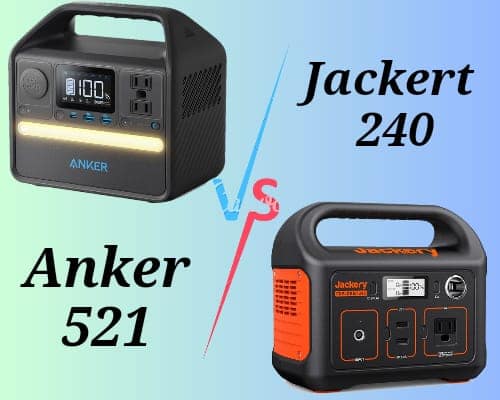
Portable power is an essential piece of gear for anyone who enjoys spending time outdoors. Whether you’re camping, hiking remote trails, or need a reliable backup for power outages at home, having a portable battery can be a real lifesaver. However, with so many options on the market, it can be tough to choose the right one for your needs and budget.
In this review, we’ll take an in-depth look at two popular portable power station brands – the Anker 521 vs. Jackery Explorer 240. Both have earned strong reputations as top performers in their class. However, they also have some key differences that may sway your decision one way or the other depending on how you intend to use your portable battery.
We’ll examine important factors like battery capacity, power output levels, charging speeds, weight, and dimensions. We’ll also break down the feature sets of each including things like charging ports, included accessories and each company’s reputation for customer service and warranty coverage.
By the end, our goal is for you to have a clear understanding of how these power stations compare so you can determine the best fit for keeping your gear powered up whether at home or in the great outdoors. So without further ado, let’s get started with our comparison of the Anker 521 vs Jackery Explorer 240 portable power stations!
Anker 521 Vs. Jackery Explorer 240
First Impressions
When it comes to portable power solutions, there are a lot of options on the market these days. As someone who enjoys spending time outdoors, whether it’s camping, hiking, or just relaxing at the park, having a reliable backup battery is essential. But with so many brands and models to choose from, it can be tough to decide which power station is right for your needs.
After much research, I narrowed it down to two top contenders – the Anker 521 PowerHouse and the Jackery 240 Portable Power Station. On the surface, these two batteries seem quite similar. Upon closer inspection, I discovered some key differences between the Anker and Jackery models that may sway your decision one way or the other.
First impressions are important, so let’s start by considering the overall aesthetic. Straight out of the box, the Anker 521 has a sleeker, more contemporary look with rounded edges and a stylish gray finish. It definitely has more visual appeal in my opinion. The Jackery, on the other hand, has a no-frills boxy design with sharp corners and a basic black coating. Function over form seems to be their priority.
When it comes to size, the Anker is also a tad wider and taller than the Jackery. This may be a con for some looking for a more compact battery. However, the extra real estate allows the Anker to pack in a higher capacity battery. More on that in a bit.
There are some differences between both features, so I’d like to elaborate on them in the following table:
| Anker 521 | Jackery 240 | |
|---|---|---|
| AC Output | 2 Ports: 110V, 1.82A (50Hz/60Hz, 200W max continuous) | 1 Port: 110V, 1.82A (60Hz, 400W surge peak, 200W max continuous) |
| USB-A Output | 2 Ports (5V, 3.6A / 2.4A Max for each port) | 2 Ports (5V, 2.4A / 24W Max) |
| USB-C Output | 1 Port (60W Max) | Not Available |
| DC Input | 11-28V, 5.5A (65W Max) | 12-30V, 3.5A (65W Max) |
| Car Charger Output | 1 Port: 12V, 10A | 1 Port: 12V, 10A |
| Weight | 3.7kg | 3kg |
| Size (LxWxH) | 8.5 x 8.32 x 5.67 in | 5.2 x 9.1 x 7.7 in |
| Lifecycle | 3000 cycles to 80%+ capacity | 500 cycles to 80%+ capacity |
| Cell Type | Lithium-ion (LiFePO4) | Lithium-ion |
| Operating Temperature | 32°F-104°F / 0°C-40°C | 14°F-104°F /-10°C-40°C |
| Warranty | 5 yrs full device warranty | 2 yrs, (free 1-year warranty for online registration) |
Portability: Anker 521 Vs. Jackery Explorer 240
While having more power is certainly appealing, portability was also high on my priority list when choosing a portable power station. After all, what’s the point of having a backup battery if it’s too bulky or heavy to realistically take with you on outdoor excursions?
Luckily, both the Anker and Jackery models are quite portable given their battery capacities. But upon weighing them side by side, their differences in size and weight became apparent. The Anker 521 PowerHouse tips the scales at 3.7 Kg compared to the Jackery 240’s 3kg. That’s a noticeable 700 gm advantage for the Jackery.
In terms of dimensions, the Anker is also larger – measuring 8.5 x 8.32 x 5.67 inches versus the Jackery’s 5.2 x 9.1 x 7.7 inches. So while the Anker can power devices for much longer on a charge, its larger and heavier design may put some people off in terms of true portability.
At the battery capacities and weights we’re dealing with here, easy carrying is key in my book. I want to be able to toss the power station in my backpack or day bag without thinking twice. With the Jackery being almost a full pound lighter than the Anker, I give it the win in this category. Both are still very portable options overall. But that extra weight starts to matter more the further you take the battery from your vehicle.
Of course, not everyone will find the same difference in weight to be significant. And it’s worth noting that Anker’s designers have still managed to make the 521 feel quite compact and balanced to carry despite its larger size. So for some, the benefits of increased capacity may outweigh the portability advantages of the Jackery. As with many things, it comes down to personal preferences and needs.
Battery capacity and power: Anker 521 Vs. Jackery Explorer 240
When it comes to portable power solutions, battery capacity is king. After all, the more energy a battery can store, the longer it will be able to keep your devices charged in between recharges.
Looking at the specs, it’s clear the Anker 521 PowerHouse has an edge over the Jackery 240 in this important category. With its 256Wh lithium-ion battery, the Anker can store about 6% more energy than the Jackery’s 241Wh unit.
On the surface, 15Wh may not seem like a massive difference. But when you’re deep in the backcountry far from the nearest outlet, every extra watt-hour counts. The Anker’s larger battery means being able to charge smartphones multiple times instead of just once before needing to top the battery off.
It also translates to longer runtimes powering devices like laptops. For example, the Anker can keep my 15-inch MacBook running for over 4 hours compared to just under 4 hours from the Jackery. While not a huge gap, those extra minutes of runtime could make all the difference when deadline writing in the field.
Of course, all that additional capacity comes at the cost of portability as discussed earlier. But for applications where weight isn’t the primary concern, the Anker’s larger battery is definitely appreciated.
So when it comes down to it, the Anker 521 PowerHouse deserves the win in this category thanks to its superior energy storage capacity. Its 256Wh battery ensures you’ll have plenty of portable power on hand no matter how long your adventures last.
| Anker 521 | Jackery 240 | |
|---|---|---|
| Battery Capacity | 256Wh | 240Wh |
| Surge Power | 450W | 400W |
| Battery Power | 200W | 200W |
Recharge Times: Anker 521 Vs. Jackery Explorer 240
Recharging times can make a big difference when you rely on portable power stations for extended outdoor excursions. Being able to top off the battery quickly is so important, especially in emergencies or when trying to stick to a tight schedule.
Also, you may read Bluetti AC200P vs Jackery 1500.
From the specs provided, it’s clear the Anker 521 PowerHouse has an advantage over the Jackery 240 in this department. Its lithium-ion battery charges up in just 2.5 hours using the included wall charger. That’s a full 3 hours faster than the Jackery’s 5.5-hour recharge time.
Three hours may not sound like a lot. But when you factor in things like weather delays, equipment malfunctions, or an unexpected night stuck in the backcountry, having a battery that recharges almost twice as fast could be a lifesaver.
The ability to fully power my devices for an extra day thanks to faster charging could make or break a trip. And in emergency situations like power outages, shaving hours off the recharge cycle allows these batteries to cycle through powering critical items much more efficiently.
So while battery capacity and runtime are obviously important metrics, recharge times shouldn’t be overlooked either. For applications where quick turnaround is valuable, Anker’s faster charging definitely earns it bonus points in my book. Its 2.5-hour full charge is an advantage that could really pay off down the road.
Of course, battery health is also a consideration over time. But out of the box, the Anker 521 PowerHouse has a clear edge in convenience when it comes to recharging its substantial energy reserves. Its faster charging is a win, especially for uses cases with tight schedules or backup needs.
| Anker 521 | Jackery 240 | |
|---|---|---|
| AC Adapter | 2.5 hrs (0% – 100%) | 5.5 hrs (0% – 100%) |
| Solar Recharge | 4.1 hour | 5.5 hour |
| Car Recharge | – | 6.5 hour |
My Verdict
After weighing all the pros and cons of these two excellent portable power stations, I’ve come to the conclusion that the Anker 521 PowerHouse is the better overall choice for my needs. While the Jackery 240 shone in the portability department, a few other key factors swing it in the Anker’s favor.
Perhaps most importantly, the Anker’s significantly longer battery life cycle of 3000 charges compared to the Jackery’s 500 is very appealing. As someone who relies on portable power solutions frequently, I want a battery that will stand the test of time without degrading prematurely. Getting nearly 6 times the lifespan from the Anker’s lithium-ion pack is huge in my book.
Replacement costs down the road also factor into the decision. Being able to go longer between battery replacements means the Anker will save money in the long run versus the Jackery requiring more frequent swaps as its cells degrade over 500 cycles.
I also can’t underestimate the value of having more usable capacity and faster recharge times from the Anker. Its 256Wh battery and 2.5 hour charge up will better support my active lifestyle whether camping for multiple days or needing backup power during emergencies at home.
While the 1.5 pounds weight difference is noticeable, Anker’s ergonomic design still allows comfortable carrying. And for car-camping uses, the extra battery life more than makes up for its slightly reduced portability compared to the Jackery.




